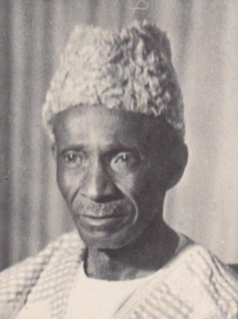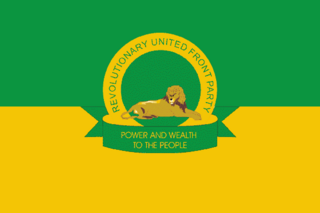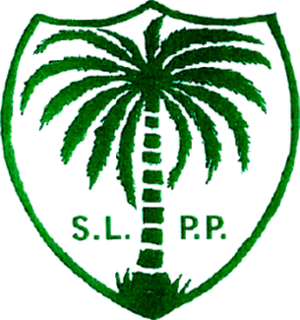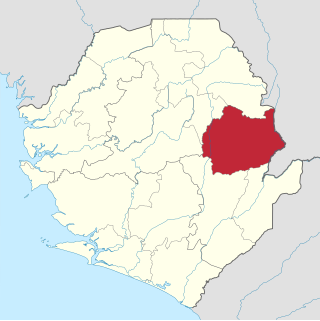Sources
- History of the Sierra Leone Peoples Party at slpp.ws
- Biography of Lamina Sankoh and other early Sierra Leoneans
The Peoples Party of Sierra Leone was a political party formed by Lamina Sankoh in 1948. The party sought to unite the British Crown Colony of Freetown with the protectorate of Sierra Leone, which were governed separately until independence in 1961. The party merged with 2 other organizations (The Protectorate Education Progressive Union and The Sierra Leone Organisation Society) in 1951 to form the Sierra Leone Peoples Party (SLPP), which is today one of the two major parties in the government of the country.

Sierra Leone, officially the Republic of Sierra Leone, informally Salone, is a country on the southwest coast of West Africa. It is bordered by Liberia to the southeast and Guinea to the northeast. Sierra Leone has a tropical climate with a diverse environment ranging from savanna to rainforests, a total area of 71,740 km2 (27,699 sq mi) and a population of 7,092,113 as of the 2015 census. The capital and largest city is Freetown. The country is divided into five administrative regions which are subdivided into sixteen districts. Sierra Leone is a constitutional republic with a unicameral parliament and a directly elected president. Sierra Leone is a Muslim majority country at approximately 78%, though with a politically influential Christian minority at about 21%. Muslims and Christians interact very well together and religious violence is extremely rare in the country. All the major Muslim and Christian holidays are officially national holidays in the country.
Sierra Leone first became inhabited by indigenous African peoples at least 2,500 years ago.The Limba were the first tribe known to inhabit Sierra Leone. The dense tropical rainforest partially isolated the region from other West African cultures, and it became a refuge for peoples escaping violence and jihads. Sierra Leone was named by Portuguese explorer Pedro de Sintra, who mapped the region in 1462. The Freetown estuary provided a good natural harbour for ships to shelter and replenish drinking water, and gained more international attention as coastal and trans-Atlantic trade supplanted trans-Saharan trade.

Sir Milton Augustus Strieby Margai was a Sierra Leonean doctor and politician who served as the country's head of government from 1954 until his death in 1964. He was titled Chief Minister from 1954 to 1960, and then Prime Minister from 1961 onwards. Margai studied medicine in England, and upon returning to homeland became a prominent public health campaigner. He entered politics as the founder and inaugural leader of the Sierra Leone People's Party. Margai oversaw Sierra Leone's transition to independence, which occurred in 1961. He died in office aged 68, and was succeeded as prime minister by his brother Albert. Margai enjoyed the support of Sierra Leoneans across classes, who respected his moderate style, friendly demeanor, and political savvy.

The Revolutionary United Front (RUF) was a rebel army that fought a failed eleven-year war in Sierra Leone, starting in 1991 and ending in 2002. It later developed into a political party, which still exists today. The three most senior surviving leaders, Issa Sesay, Morris Kallon and Augustine Gbao, were convicted in February 2009 of war crimes and crimes against humanity.

Alhaji Ahmad Tejan Kabbah was a Sierra Leonean politician who served twice as the 3rd President of Sierra Leone, from 1996 to 1997 and again from 1998 to 2007. An economist and attorney by profession, Kabbah spent many years working for the United Nations Development Programme. He retired from the United Nations and returned to Sierra Leone in 1992.

The Sierra Leone People's Party (SLPP) is one of the two major political parties in Sierra Leone, along with the All People's Congress (APC). It is the current ruling party in Sierra Leone since 4 April 2018.

Siaka Probyn Stevens was the leader of Sierra Leone from 1967 to 1985, serving as Prime Minister from 1967 to 1971 and as President from 1971 to 1985. Stevens' leadership was often characterized by patrimonial rule and self-indulgence, consolidating power by means of corruption and exploitation.

The Lomé Peace Agreement was a peace agreement signed on 7 July 1999 between the warring parties in the civil war that gripped Sierra Leone for almost a decade. President Ahmad Tejan Kabbah signed with the Revolutionary United Front (RUF) leader, Foday Sankoh and granted Sankoh a position in the transitional government as well as amnesty for him and all combatants. The accord is named for Lomé, the capital of Togo, where the negotiations took place and the agreement was signed.
Sir Albert Michael Margai was the second prime minister of Sierra Leone and the half-brother of Sir Milton Margai, the country's first Prime Minister. He is also the father of Sierra Leonean politician Charles Margai.
Charles Francis Kondo Margai is a Sierra Leonean politician and constitutional lawyer who served as Attorney General and Minister of Justice of Sierra Leone in 2018.

Kono District is a district in the Eastern Province of Sierra Leone. Its capital and largest city is Koidu Town. Motema is the second most populous city in the district. The other major towns in the district include Yengema, Tombodu, Jaiama Nimikor and Sewafe. The district is the largest diamond producer in Sierra Leone. The population of Kono District is 505,767. Kono District borders Kenema District to the southwest, The Republic of Guinea to the east, Koinadugu District to the northeast and Kailahun District to the southeast. Kono District is divided into fourteen chiefdoms.

Kailahun District is a district in the Eastern Province of Sierra Leone. Its capital and largest city is the town of Kailahun. The second most populous city in the district is Segbwema. Other major towns in Kailahun District unclude Koindu, Pendembu and Daru. As of the 2015 census, the district had a population of 525,372. Kailahun District is subdivided into fourteen chiefdoms.

Kenema District is a district in the Eastern Province of Sierra Leone. Its capital and largest city is Kenema, which is the third most populous city in Sierra Leone, after Freetown and Bo. Tongo is the second most populous city in the district. Other major towns in Kenema District include Blama and Yomboma. The district is the most populous district in the Eastern province with a population 609,873. Kenema District has an area of 6,053 km2 (2,337 sq mi) and comprises sixteen chiefdoms.
Articles related to Sierra Leone include:
Lamina Sankoh, born as Etheldred Nathaniel Jones, was a Sierra Leonean pre-independence politician, educator, banker and cleric. Sankoh is known most prominently for helping to found the Peoples Party in 1948, one of the first political parties in Sierra Leone. It eventually became the Sierra Leone People's Party.
The National Council of Sierra Leone was the main opposition party in Sierra Leone in the early 1950s.
The National Alliance Democratic Party is a political party in Sierra Leone.
Julius Momoh Gulama was a Sierra Leonean paramount chief, statesman and educator in the preindependence era. As paramount chief of Kaiyamba Chiefdom, he ruled the largest and most powerful Mende chiefdom in the Sierra Leone.

General elections were held in Sierra Leone Colony and Protectorate in November 1951.
The Church of the Holy Trinity or Holy Trinity Church or Trinity Church is an Anglican church located on Kissy Road in Freetown, Sierra Leone. The church was one of the most prestigious Anglican churches in Freetown alongside or after St. George's Cathedral, Freetown.